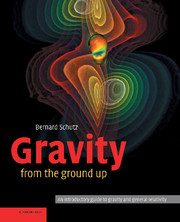Book contents
- Frontmatter
- Contents
- Preface
- Background: what you need to know before you start
- 1 Gravity on Earth:
- 2 And then came Newton
- 3 Satellites
- 4 The Solar System
- 5 Tides and tidal forces
- 6 Interplanetary travel
- 7 Atmospheres
- 8 Gravity in the Sun
- 9 Reaching for the stars
- 10 The colors of stars
- 11 Stars at work
- 12 Birth to death
- 13 Binary stars
- 14 Galaxies
- 15 Physics at speed
- 16 Relating to Einstein
- 17 Spacetime geometry
- 18 Einstein's gravity
- 19 Einstein's recipe
- 20 Neutron stars
- 21 Black holes
- 22 Gravitational waves
- 23 Gravitational lenses
- 24 Cosmology
- 25 The Big Bang
- 26 Einstein's Universe
- 27 Ask the Universe
- Appendix: values of useful constants
- Glossary
- Index
23 - Gravitational lenses
Bringing the Universe into focus
Published online by Cambridge University Press: 05 June 2012
- Frontmatter
- Contents
- Preface
- Background: what you need to know before you start
- 1 Gravity on Earth:
- 2 And then came Newton
- 3 Satellites
- 4 The Solar System
- 5 Tides and tidal forces
- 6 Interplanetary travel
- 7 Atmospheres
- 8 Gravity in the Sun
- 9 Reaching for the stars
- 10 The colors of stars
- 11 Stars at work
- 12 Birth to death
- 13 Binary stars
- 14 Galaxies
- 15 Physics at speed
- 16 Relating to Einstein
- 17 Spacetime geometry
- 18 Einstein's gravity
- 19 Einstein's recipe
- 20 Neutron stars
- 21 Black holes
- 22 Gravitational waves
- 23 Gravitational lenses
- 24 Cosmology
- 25 The Big Bang
- 26 Einstein's Universe
- 27 Ask the Universe
- Appendix: values of useful constants
- Glossary
- Index
Summary
As we have progressed through the story set out in this book, we have met and begun to understand many of the objects that astronomers regularly photograph: planets, stars, galaxies, supernovae. Astronomical photographs show, in fact, the astonishing variety of objects that make up our Universe. But, to my eye, the most spectacular and entertaining astronomical photographs are fashioned by the objects we will study in this chapter: gravitational lenses. Let's start this chapter with two, shown in Figure 23.1 on the following page. Gravitational lenses are a spectacular illustration of the working of general relativity in the Universe. And besides entertaining us with pictures of eerie beauty, they have become an important tool of astronomy, a way of probing the distribution of mass (and in particular the dark matter) in galaxies and clusters of galaxies.
In this chapter: gravitational lensing has become one of the most important tools astronomers have for investigating the true distribution of mass in the Universe, and for measuring the Hubble expansion rate. We study how lensed images form, why lenses produce multiple images (always an odd number), why some are magnified, and how lensing and microlensing are used by astronomers.
- Type
- Chapter
- Information
- Gravity from the Ground UpAn Introductory Guide to Gravity and General Relativity, pp. 331 - 344Publisher: Cambridge University PressPrint publication year: 2003



